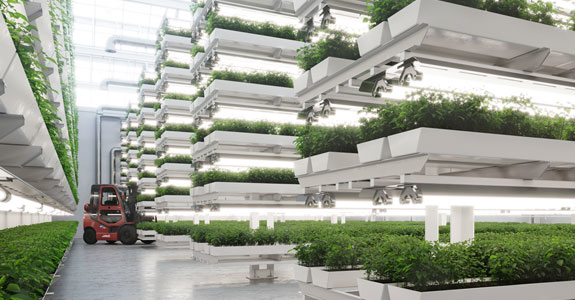Vertical growing: methods, benefits, and challenges
Advancements in technology and climate change are reshaping how and where we grow crops. Warehouses and shipping containers are popular environments for this type of growing. The rise of vertical growing is capitalizing on this shift, maximizing available space from floor to ceiling for plants and vegetables.
Traditionally, crops grow on a horizontal plane, such as on benches or floors. However, space constraints have led many growers to explore vertical farming. Recent events, including a pandemic, supply chain disruptions, and the growing demand for local food, have further encouraged businesses to rethink their strategies.
Many business in the horticultural industry are ahead of the recent shift to vertical growing since the technology needed to succeed relies on temperature, light, and humidity control—elements already well-established in settings such as greenhouses.
What are the most common vertical growing methods?
Vertical growing, also called vertical farming, maximizes space and doubles or triples the inventory within your structure since you're using nearly every square foot when you garden up-and-down, not just side-to-side. How it's done can be simple.
Here are three common methods for vertical plant growth:
Shelving
For vertical growing, your shelving should be constructed in multiple tiers with the highest tier on the wall opposite the side of the structure that gets the most sunlight. By doing this, plants on the top shelves won't shade out plants set lower.
Vertical planters
These planters usually use potting soil. Water these planters from the top. Gravity does the rest. Strawberries and lettuce are two crops commonly grown in vertical planters with great success.
Vertical hydroponic systems
Vertical hydroponic systems use soilless gardening. Most are recirculating systems, so the nutrient solution is collected and reused. The solution is delivered to the top plant modules and gravity flows it to the bottom.
No matter which vertical method you use, it can provide bottom-line benefits including higher productivity in the same space, healthier yields, shorter growing times, and lower water use.
Vegetable gardening moves indoors, closer to metro areas
The demand for farm-to-table food continues to grow. While open fields remain a traditional source, businesses are moving vegetable production into environmentally controlled spaces like warehouses and shipping containers.
These indoor farms often operate near major metropolitan areas, allowing for faster delivery to supermarkets. With shorter transportation times, crops can be harvested, packaged, and stocked on shelves in less than a day. This freshness benefits consumers, while businesses enjoy quicker returns and reduced spoilage.
With an increase in community-centered and local area sales, businesses can also avoid some of the challenges they face when transporting products long distances. It can reduce transportation costs and delays—and product losses related to the latter.
What are the advantages of indoor vegetable growing?
Indoor vegetable growing offers numerous benefits, including:
Sustainability
In a hydroponic vertical space, water is recycled through the system, so a minimal amount of fresh water is needed once the system is running.
Year-round crop production
Since the environment is under your control, you create the optimal climate conditions for plant growth year-round and grow more plants inside per square foot compared to growing seasonal crops outside in an open field.
Reduced risk
Volatility decreases the closer you get to the supermarket shelf. There's also less need to transport your inventory and utilize your fleets.
Are there any disadvantages to vertical growing?
While there are many benefits to vertical growing, there are some drawbacks. Here are a few things to consider before diving into vertical farming:
High startup costs: Advanced technology and specialized equipment require significant investment to acquire, set up, and maintain.
Limited crop options: Space is the overriding factor here. With less room to grow, crops are usually limited to leafy greens, small vegetables, and berries.
Higher energy consumption: Vertical growing predominately relies on artificial lighting—and every layer of plants needs its own light source.
Dependence on technology: Nearly every function in a vertical growing operation relies on technology—and that technology working properly. Power outages, equipment breakdowns, and lack of experienced service technicians can lead to business interruptions.
How can your insurance provider help vertical growing businesses?
If you anticipate your business shifting to vertical growing, ask your insurance provider for guidance, especially when it comes to protecting your investment.
We offer crop insurance for plants grown in climate-controlled structures and have the experience and knowledge to assess risks horticultural businesses like yours face, including risks that could impact your greenhouse growing conditions.
If you have questions or would like to learn more about our full range of horticultural business insurance services, contact us. We’re here to help you keep your crops and assets safe.
Related links:
5 trends shaping the horticulture industry in 2025
We’ve identified five key trends that will impact your business in 2025, including rising auto costs, cybersecurity risks, and climate change—with tips to help you adapt.
A deep dive into horticultural commercial property insurance
Safeguard your horticultural business with commercial property insurance. Discover how this coverage helps protect your buildings, equipment, and inventory from threats, such as theft and severe weather.
Safeguard your business from severe weather
Don't leave your horticultural business’s survival to chance following severe weather or a natural disaster. You can prep for these events with proper planning. We have three steps to help guide you.
The information in this article is for informational or entertainment purposes only. View our disclaimer by going to terms and conditions and clicking on Learning Center disclaimer in the table of contents.
